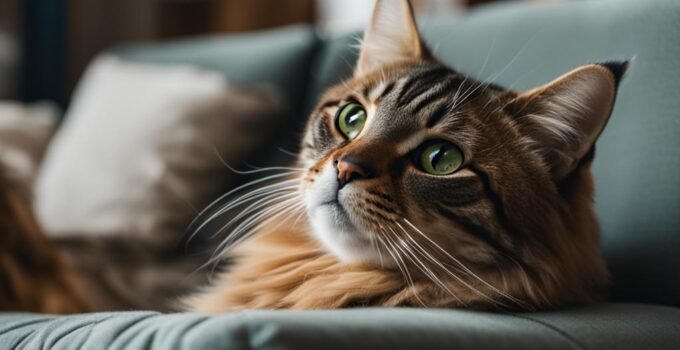Pet insurance can provide valuable peace of mind for pet parents, ensuring that their indoor cat receives the necessary medical care without incurring exorbitant veterinary bills. While it may seem that indoor cats are less susceptible to accidents and health issues, the reality is that they still face a variety of risks that can lead to unexpected expenses.
Kittens, in particular, are highly prone to injury as they explore their surroundings and engage in playful activities. Indoor cats, like their outdoor counterparts, can also encounter health problems such as toxic exposures, viral infections, urinary issues, and dental problems.
By investing in pet insurance for your indoor cat, you not only protect your furry friend’s well-being but also alleviate the financial stress that can come with unexpected emergencies and medical treatments.
Key Takeaways:
- Pet insurance provides financial security and peace of mind for pet parents of indoor cats.
- Indoor cats, including kittens, can still suffer from accidents and health issues that require veterinary care.
- Common health risks for indoor cats include toxic exposures, viral infections, urinary issues, and dental problems.
- Investing in pet insurance can help cover the costs of medical treatments, surgeries, and preventive care for indoor cats.
- Consider your cat’s specific needs, age, and potential risks when choosing a pet insurance plan.
Kittens are Highly Prone to Injury
Kittens are adorable bundles of energy, constantly exploring their surroundings and learning about the world. However, their adventurous nature can put them at risk of injuries. Their softer bones and developing muscles make them more susceptible to accidents from climbing, jumping, and falls. Common injuries in kittens include fractured legs, concussions, and soft tissue injuries.
These injuries require immediate medical attention and often involve intensive corrective surgeries and multiple follow-up appointments for rehabilitation. Treating these injuries can be expensive, putting a financial burden on pet owners.
Fortunately, pet insurance can provide the necessary coverage for kittens’ injury-related expenses, ensuring their healthy growth and development. By obtaining cat insurance for kittens, pet owners can have peace of mind knowing that they have financial protection if their furry little ones need medical care due to an accident or injury. Pet insurance for kittens covers a wide range of treatments, including surgeries, medications, and rehabilitation, making it easier for pet owners to focus on their kittens’ recovery without worrying about the financial strain.
Moreover, with the right pet insurance coverage, pet owners can also access additional benefits such as 24/7 helplines and advice from veterinary professionals, ensuring that they make informed decisions for their kittens’ well-being.
Protecting Your Kitten’s Future
Investing in cat insurance for kittens safeguards their health and ensures that they receive prompt and adequate medical care in the event of an injury. It allows pet owners to prioritize their kittens’ well-being without being hindered by the burden of unexpected veterinary bills.
Remember, accidents can happen at any time and to any kitten, so it’s essential to be prepared. By getting pet insurance for your kitten, you can provide the protection they need and the peace of mind you deserve.
Indoor Cats Face Similar Health Risks as Outdoor Cats
Contrary to popular belief, indoor cats can still face health risks comparable to outdoor cats. Despite being protected from certain dangers such as traffic accidents and predation, indoor cats are vulnerable to a range of health issues that can impact their well-being. It is essential for cat owners to be aware of these risks and ensure their indoor feline companions receive the necessary medical care.
Indoor cats are at risk of trauma, which can result from falls, accidents, or interactions with other household pets. These incidents can lead to injuries such as fractured bones, concussions, or soft tissue damage.
Wound abscesses are another concern for indoor cats. Even though they may not be exposed to outdoor hazards, indoor cats can still experience injuries that may become infected and develop into abscesses.
Toxic exposures are not exclusive to outdoor environments. Indoor cats can come into contact with toxic substances found in common household items such as cleaning products or plants. Ingestion or inhalation of these toxins can have detrimental effects on their health.
Viral infections can also affect indoor cats. While they may not be exposed to the same level of risk as outdoor cats, indoor felines can still contract viral diseases such as feline panleukopenia and feline herpesvirus.
Parasites and insects, such as fleas, ticks, and mosquitoes, can find their way into indoor spaces, posing a risk to the health of indoor cats. These parasites can transmit diseases, cause discomfort, and contribute to other health issues.
Respiratory diseases are also prevalent in indoor cats, especially in multi-cat households or environments with poor air quality. Cats can develop respiratory infections or conditions such as asthma, which can lead to breathing difficulties and other complications.
Furthermore, indoor cats have a higher risk of urinary issues and dental problems. These conditions can cause discomfort, pain, and require veterinary intervention. Proper medical care is crucial to prevent these issues from escalating and affecting the overall well-being of the cat.
Given the potential health risks that indoor cats face, it is essential for cat owners to consider pet insurance coverage. Pet insurance provides financial protection and ensures that indoor cats receive timely and appropriate medical care for accidents, injuries, and illnesses. With the right insurance coverage, cat owners can have peace of mind knowing that their indoor companions are safeguarded against unexpected health issues.
| Common Health Risks for Indoor Cats | Pet Insurance Coverage |
|---|---|
| Trauma from falls, accidents, or interactions with other pets | ✔️ |
| Wound abscesses from injuries | ✔️ |
| Toxic exposures from household items or plants | ✔️ |
| Viral infections such as feline herpesvirus | ✔️ |
| Parasites and insects (fleas, ticks, mosquitoes) | ✔️ |
| Respiratory diseases from poor air quality | ✔️ |
| Urinary issues | ✔️ |
| Dental problems | ✔️ |
Indoor Cats Have a Higher Risk of Certain Health Issues
Indoor cats may live a relatively sheltered life, but they are still susceptible to specific health issues that require attention and care. Understanding these risks is crucial for every cat owner, as it highlights the importance of having pet insurance for their indoor companion.
Urinary Issues
Indoor cats have an increased risk of developing urinary issues, including blockages. These blockages can be life-threatening and require immediate veterinary intervention. Treating urinary blockages often involves procedures, such as catheterization or surgery, which can result in significant medical expenses.
Weight Gain and Associated Health Problems
Indoor cats are more prone to weight gain due to a lack of physical activity. This excess weight can lead to various health problems, including arthritis and diabetes. Managing weight-related issues in cats requires a combination of diet control and regular exercise. Pet insurance can cover the cost of weight management programs, medications, and treatments for associated health conditions.
Dental Problems
Dental problems are prevalent in cats, and indoor cats are no exception. Poor dental hygiene can lead to gum disease, tooth decay, and even systemic health issues. Regular dental care, including professional cleanings and potential extractions, is essential for maintaining your indoor cat’s oral health. Pet insurance can help alleviate the financial burden of dental treatments.
| Health Issue | Risk Factors | Treatment |
|---|---|---|
| Urinary Issues | Lack of physical activity | Catheterization, surgery |
| Weight Gain | Lack of exercise | Weight management programs, medications |
| Dental Problems | Poor dental hygiene | Professional cleanings, potential extractions |
The Cost of Pet Care Increases with Age
As cats age, their healthcare needs typically increase, leading to higher veterinary costs. Older cats are more prone to chronic conditions, such as kidney disease and diabetes, which require ongoing medical care. Pet care costs increase with age, placing an additional financial burden on pet owners.
To manage the growing expenses of senior cat care, pet insurance becomes crucial. While the cost of pet insurance premiums may increase as cats get older, having coverage can help offset the rising veterinary costs associated with age-related health issues. It provides peace of mind and ensures that older cats receive the necessary medical attention without causing financial strain.
Let’s take a closer look at some common age-related health issues in older cats and how pet insurance can help manage their costs:
| Age-Related Health Issues | Estimated Treatment Costs |
|---|---|
| Kidney Disease | $1,000 – $5,000 per year* |
| Diabetes | $500 – $2,000 per year* |
*Estimated costs may vary depending on the severity of the condition, required treatments, and geographic location.
Pet insurance for older cats can provide coverage for these chronic conditions, including diagnostic tests, medications, and regular check-ups. By having a comprehensive insurance plan, pet owners can focus on their cat’s well-being and provide the necessary care without worrying about the financial implications.
Investing in pet insurance for older cats is a proactive approach to ensure their health and happiness in their senior years. By managing the rising costs of veterinary care, pet insurance offers peace of mind and allows pet owners to make the best decisions for their furry companions.
Indoor Cat Insurance Promotes Routine Care
As a responsible pet parent, it’s essential to prioritize routine care for your indoor cat. Regular check-ups, vaccinations, and teeth cleanings not only contribute to their overall well-being but also play a significant role in promoting longevity. By investing in pet insurance for your indoor cat, you can ensure that they receive the necessary preventive care to stay healthy and happy.
Routine care visits to the veterinarian are crucial for early detection of illnesses and the prevention of more severe conditions. Regular check-ups allow the veterinarian to assess your cat’s overall health, identify any potential issues, and recommend appropriate treatment plans. Vaccinations help protect your feline friend from common diseases, while teeth cleanings prevent dental problems that can lead to discomfort and serious health issues.
Pet insurance plans often include coverage for preventive care, making it easier for pet parents to afford regular veterinary visits and necessary procedures. With insurance coverage, you can schedule routine check-ups without worrying about the financial burden. This means you can provide your indoor cat with consistent, high-quality care, helping them live a longer and healthier life.
Additionally, routine care visits give you the opportunity to discuss any concerns or questions you may have with your veterinarian. They can provide valuable advice on nutrition, behavior, and overall cat care, ensuring that you have the knowledge and resources to provide the best possible care for your indoor cat.
| Routine Care Benefits: |
|---|
| Early detection of illnesses |
| Prevention of more severe conditions |
| Protection from common diseases through vaccinations |
| Prevention of dental problems |
Different Types of Pet Insurance for Indoor Cats
When it comes to insuring your indoor cat, there are various types of pet insurance plans to choose from. These plans cater to different needs and budgets, providing coverage for both accidents and illnesses or focusing solely on accidents. To find the best pet insurance for your indoor cat, it is important to compare different providers and carefully review the policy details.
Comprehensive pet insurance plans offer coverage for both accidents and illnesses. They provide financial protection in case your indoor cat requires medical treatment for injuries, illnesses, or chronic conditions. With comprehensive coverage, you can have peace of mind knowing that your feline companion will receive the necessary care without stressing about overwhelming veterinary expenses.
On the other hand, accident-only pet insurance plans are designed to cover unexpected accidents and injuries. While they may not offer coverage for illnesses or chronic conditions, accident-only plans can still provide vital financial support in case your indoor cat encounters an accident that requires veterinary attention.
When choosing the best pet insurance for your indoor cat, consider factors such as the premium costs, deductibles, reimbursement percentages, and coverage limits. It’s also crucial to read the policy details to understand any exclusions or waiting periods. By assessing these factors, you can ensure that the pet insurance plan you select aligns with your budget and provides comprehensive coverage for your indoor cat’s specific needs.
Ultimately, the best pet insurance for your indoor cat will depend on your preferences and financial capabilities. Take the time to compare different plans, read customer reviews and ratings, and consult with your veterinarian if needed. By making an informed decision, you can provide the best possible care for your indoor cat while protecting yourself from unexpected veterinary expenses.
Factors to Consider When Getting Pet Insurance for an Indoor Cat
When insuring an indoor cat, there are several important considerations to keep in mind. By evaluating these factors, you can make an informed decision and choose the right pet insurance policy for your beloved feline companion.
1. Age and Health Condition: Assess your cat’s age and overall health condition. Older cats may have pre-existing conditions that require coverage, while younger cats may benefit from comprehensive insurance that includes preventive care.
2. Specific Risks: Consider any specific risks your indoor cat may face. For example, if you have plants that are toxic to cats or live in an area prone to natural disasters, you may want coverage for potential emergencies.
3. Cost of Premiums: Compare the premiums offered by different insurance providers. Take into account your budget and the level of coverage each policy provides. Remember that cheaper premiums may offer fewer benefits or have higher deductibles.
4. Deductibles and Reimbursement Percentages: Understand the deductibles and reimbursement percentages associated with the policy. A higher deductible may mean lower premiums, but you’ll have to cover more out-of-pocket expenses. Reimbursement percentages determine how much of the veterinary costs are covered by the insurance.
5. Coverage Limits: Review the coverage limits of each policy. Some insurance plans may have an annual limit or a lifetime limit on claims. Ensure that the coverage adequately meets your cat’s potential medical needs.
6. Policy Terms: Read the policy terms thoroughly, paying attention to exclusions and waiting periods. Exclusions are specific conditions, treatments, or procedures that are not covered by the insurance. Waiting periods are the time you need to wait before certain benefits become available.
By carefully considering these factors, you can select a pet insurance policy that provides the right level of coverage for your indoor cat’s unique needs.
| Factors to Consider | Importance |
|---|---|
| Age and Health Condition | Assess the cat’s specific needs and potential pre-existing conditions |
| Specific Risks | Consider any unique risks your indoor cat may face |
| Cost of Premiums | Compare premiums and choose based on budget and coverage needs |
| Deductibles and Reimbursement Percentages | Understand how much you’ll pay out-of-pocket and what expenses are covered |
| Coverage Limits | Ensure the policy provides adequate coverage for potential medical needs |
| Policy Terms | Read and understand exclusions and waiting periods |
Why Indoor Cats Need Pet Insurance
Indoor cats may seem safe and protected within the confines of our homes, but they are not immune to accidents, injuries, and health issues. That’s why it’s essential to have pet insurance for indoor cats to ensure their well-being and provide financial security for unexpected medical expenses.
While indoor cats may not face the same risks as outdoor cats, they are still prone to various health problems that require veterinary care. Common issues include urinary tract infections, dental problems, weight gain, and even chronic diseases as they age. Pet insurance for indoor cats helps pet parents afford the necessary medical treatments, surgeries, and preventive care to keep their feline companions healthy and happy.
Benefits of Pet Insurance for Indoor Cats
Pet insurance offers several key benefits for indoor cats:
- Financial Security: Unexpected accidents and illnesses can lead to costly veterinary bills. Pet insurance provides financial protection, ensuring that pet parents can provide the best care for their indoor cats without worrying about the expense.
- Timely Medical Care: With pet insurance, pet parents can promptly seek medical attention for their indoor cats whenever necessary. This includes routine check-ups, vaccinations, preventive treatments, and emergency care, ensuring that any potential health issues are addressed without delay.
- Peace of Mind: Knowing that their indoor cats are covered by pet insurance gives pet parents peace of mind. They can have confidence in making decisions about their cat’s healthcare, knowing that they have financial support to provide the best care possible.
- Preventive Care: Pet insurance often includes coverage for preventive care, such as annual wellness exams, vaccinations, and dental cleanings. These preventive measures help detect potential health issues early and can prevent more significant problems down the road.
By investing in pet insurance for indoor cats, owners can ensure that their feline friends receive the necessary care they need throughout their lives. Whether it’s routine check-ups or emergencies, pet insurance offers the peace of mind and financial support to give indoor cats the best possible quality of life.
Conclusion
After careful consideration, it is clear that pet insurance for indoor cats is a beneficial investment. While indoor cats may not face the same risks as their outdoor counterparts, they are still susceptible to accidents, injuries, and specific health issues. Pet insurance provides pet owners with peace of mind, knowing that they can afford the necessary medical care for their beloved indoor furry companions.
In addition to financial security, pet insurance also promotes routine care for indoor cats. Regular check-ups, vaccinations, and dental cleanings play a crucial role in detecting illnesses early and preventing more severe conditions. By including coverage for preventive care, pet insurance plans make it easier for pet owners to prioritize their indoor cat’s health and well-being.
When considering pet insurance for an indoor cat, it is essential to evaluate the cat’s age, health condition, and specific risks. Comparing different pet insurance options and reading the policy details ensures that pet owners choose a plan that offers comprehensive coverage at an affordable price. By doing so, they can provide their indoor cats with the necessary medical attention without financial burdens.
In conclusion, pet insurance for indoor cats is worth considering. It not only protects against potential health risks but also promotes routine care and grants peace of mind. By evaluating the cat’s needs and comparing different pet insurance options, pet owners can find the perfect plan to safeguard their indoor cat’s health and ensure their well-being for years to come.



